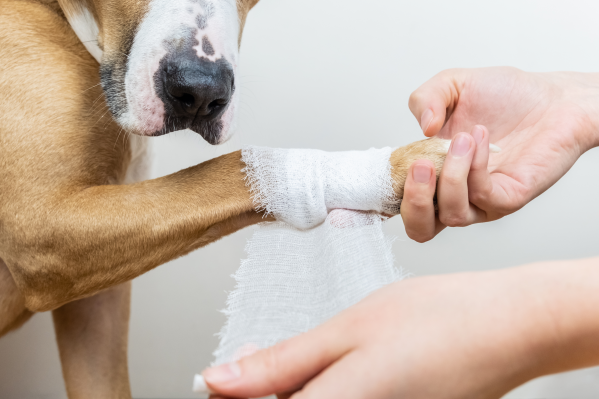Summer is in full swing! You and your pup will no doubt want to spend as much time as you can outside doing things like hiking, swimming, camping, or other activities that take advantage of the warm summer weather.
While you and your dog should enjoy all of these things, an uptick in outdoor activities also means that your pup is more likely to get injured, especially on their paws.
Here’s an overview of paw injuries you should look out for this summer, how you can reduce the risk of them occurring, and how you can treat them if they happen.
Paw injuries to look out for
While your dog’s paws are made of much stronger stuff than our own feet, there are still situations where they can become injured.
Foxtails—the seeded tops of several types of grasses, are a common issue for dogs in the summer months. These pointy seeds can burrow their way into your pup’s paws and leave a dark pink blister in its wake.
Seasonal allergies—something that dogs are prone to just like us humans, can also cause inflammation and create abrasions on paw pads.
Burns from hot pavement—the pavement can become significantly hotter than the air around you and can burn your pup’s paws if it gets hot enough.
Fungal infections
Cuts—caused by sharp objects on the ground like rocks or broken glass
Signs of a paw pad injury
While there are several causes for paw pad injuries, the symptoms are often similar. If your dog’s paws hurt them, they might start to limp, and you might also see them gnawing or licking the affected area.
If the pavement is too hot, your dog may pull on a leash in an attempt to get to a cooler area, and the pads themselves may become inflamed or blistered. If they have a cut or a puncture wound, you can see the cut itself bleeding or see loose flaps on the pad itself. Dogs can also become lethargic and have swelling in the paws or joints on the affected limb.
How to reduce the risk of a paw injury
While you can’t remove the risk of paw injury completely, there are things you can do to lessen the chances that your pup gets hurt.
“Avoid walking out during the middle of a summer day or out in the sun—try to stay in the shade and be cognizant of glass or sharp objects that may be lying around on the ground,” suggests Dr. Yui Shapard. "The easiest way to avoid paw pad injuries (if the dog tolerates it) would be to apply booties to physically protect their paws.”
What to do if you notice a paw pad injury
If you do notice a paw pad injury on your pup, you should get in touch with your veterinarian, especially if you think the injury came from a foxtail or if the wound is so severe that your dog has trouble walking.
“You can try a home remedy with a saline solution to clean the injured site, but it would be best to have the dog’s paws checked by a veterinarian to assess the severity and make sure the dog is getting adequate treatment and pain relief if needed,” says Dr. Shapard.
If you have to wait a bit before your vet appointment, you can keep your dog’s wound clean and free of contaminants and debris by soaking it in lukewarm water. Dr. Shapard also recommends putting an Elizabethan collar on the dog to stop them from gnawing or licking the injury.
Depending on the severity of the wound, there may be a specific antimicrobial solution like chlorhexidine that pet parents will be instructed to dilute and do a foot soak on the injured paw. Your vet might also recommend putting the whole paw in a waterproof booty or plastic bag to keep it clean and dry when you go outside. For burns, your vet might recommend putting some antibiotic ointment on it, depending on the severity of the burn, before bandaging it as well.
These precautions will likely not be well-received by your pup, but doing so will help your dog heal faster and have them soon back to their old self again.
Wondering if your dog's paw is injured? The experts at Pawp are available 24/7 to help you with any specific questions you have about the health of your pup, from their paws to the tip of their snout.

Reviewed and fact-checked by
Yui Shapard, BVM&S, MRCVS and Medical Director at Pawp
